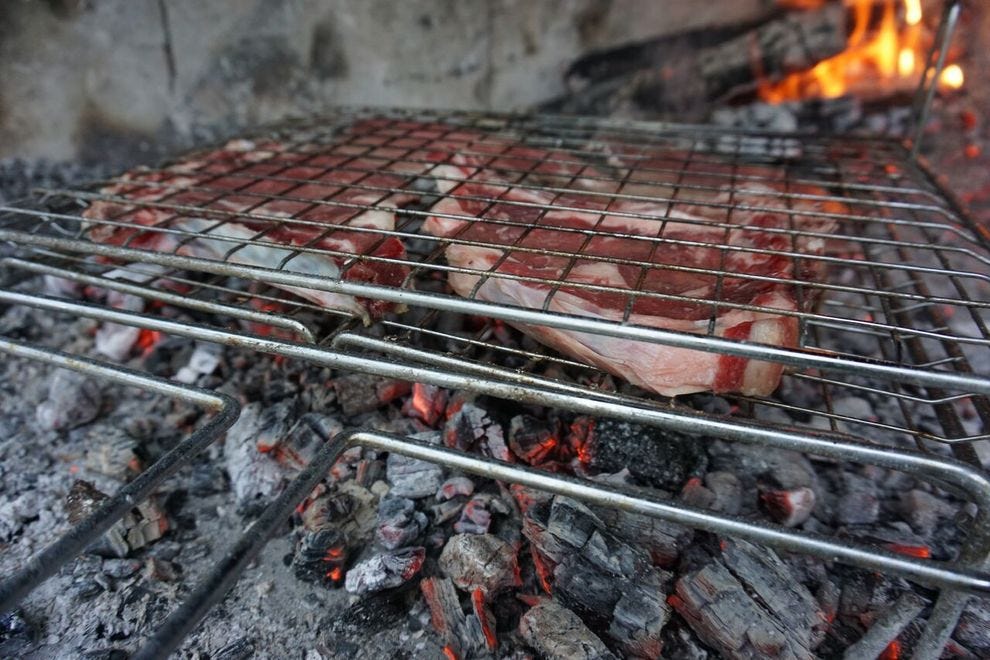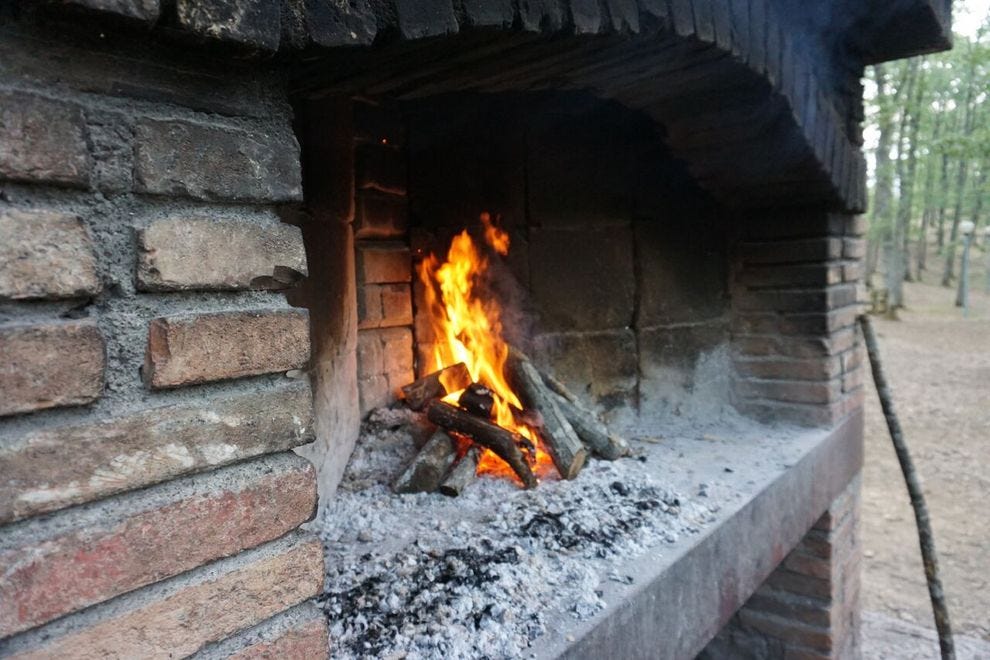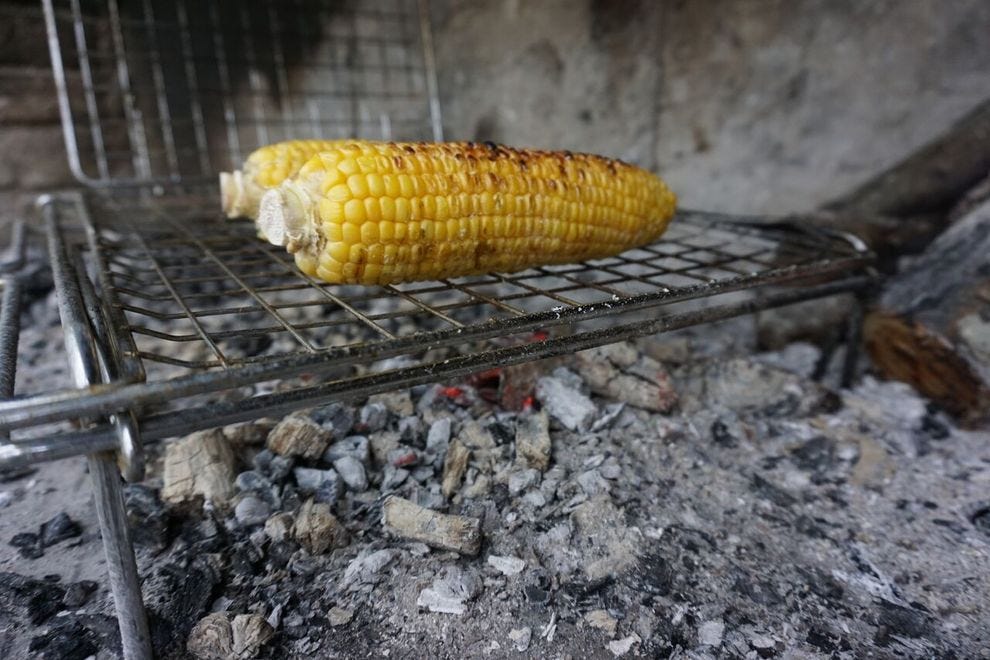How to cook over a wood fire
Anthropologists and paleontologists have found evidence that homo erectus, our upright-walking ancestors, ate cooked meat – perhaps as early as 1 million years ago or more. Their descendants, the ill-fated Neanderthals and more fortunate homo sapiens – that would be us – most certainly did.
Since our earliest antecedents were scavengers of animal carcasses left behind by predators much, much higher on the food chain, their ability to cook the Pleistocene equivalent of roadkill meant they could kill bacteria in spoiled meat, make it easier to digest and reap more developmental benefits from the food.
Vegans may be the more highly evolved primates of the modern age, but archaically, cooked meat made us what we are.
 Steak over a wood fire — Photo courtesy of Elizabeth Heath
Steak over a wood fire — Photo courtesy of Elizabeth Heath
For millennia, cooking anything, whether it was a woolly mammoth steak or a pot of medieval gruel, meant cooking over a wood fire. And well into the 20th century, grilling meant grilling with wood. But with the post-WWII migration to the suburbs, backyard barbecuing officially became a thing.
Charcoal briquettes – a joint-effort invention of Henry Ford and Thomas Edison, no less – caught on as the clean, space-saving way to fire up those newfangled Weber grills. Briquettes caught fire easily, burned slowly and evenly, and made it possible for even the most inept of weekend warriors to be masters of their meat.
Portable propane gas grills were also introduced in the 1950s, requiring even fewer primordial skills. As gas vs. charcoal loyalists chose their sides of the badminton net, wood as a cooking fuel got relegated to the ash heap of history.
But it’s time we rediscover that grilling with wood makes food taste better. Seriously, it’s a revelation what a difference a wood fire makes in the flavor of grilled meats, vegetables and even bread.
It’s not that much more difficult or time-consuming than using briquettes or gas, though it does take longer than gas-grilling and requires some time management (unless you want to eat at midnight). Cooking with wood also imparts that pseudo-survivalist sense of accomplishment – you know, like pitching a tent and sleeping in the backyard.
How to cook over a wood fire
Before you start looking for two sticks to rub together, here’s a primer for how to cook over a wood fire, with a 21st-century assist, in the form of a lighter and a couple of fire-starter cubes (the eco-friendly variety):
 Lit fire-starter cube — Photo courtesy of Elizabeth Heath
Lit fire-starter cube — Photo courtesy of Elizabeth Heath
- Use seasoned (dried) oak or another hardwood, like walnut, ash or hickory. Pine or any resin-laden wood is a no-no – it burns too fast and creates an acrid smoke and an unpleasant taste in food.
- Stack the wood in a teepee shape. If you don’t have or don’t wish to use a starter cube, form the teepee around a small pile of kindling wood. If you want to go full-on Grizzly Adams, you can use dried grass and moss as kindling. Light the kindling or cube(s).
 Wood beginning to burn — Photo courtesy of Elizabeth Heath
Wood beginning to burn — Photo courtesy of Elizabeth Heath
- Wait for wood to burn and start to break down into embers. (This will probably take 30-45 minutes.) With a shovel, a metal rake or other gardening tool, help things along by breaking up the red-glowing wood into chunks.
- With the burning wood at the back of the fire pit or BBQ grill, use the shovel or other implement to spread the embers out in an even layer at the front.
 Corn on the cob cooking over embers — Photo courtesy of Elizabeth Heath
Corn on the cob cooking over embers — Photo courtesy of Elizabeth Heath
- Lay the grill grate on top of the embers. You can use a cast-iron grate or a lighter-weight stainless steel one.
- Place meat and vegetables on the grill with minimal seasoning – maybe just a little olive oil and salt. The smoke will do the flavoring.
 Steak cooking over embers — Photo courtesy of Elizabeth Heath
Steak cooking over embers — Photo courtesy of Elizabeth Heath
- Remember that you should cook over embers, not over flames. The occasional flare-up is okay, but the method is slow, steady heat, not searing.
- As needed, spread more embers from the fire onto the cooking area.
Virtually any kind of grill where you’d use charcoal will work with wood. In Italy and other places where grilling with wood is the norm, you’ll often see big cast-iron grills with a rack for the burning wood – the embers drop down under the rack and can be scooped out for cooking. Otherwise, a campfire pit, an outdoor fireplace or a charcoal BBQ grill can work just as well.
There’s an old-school, slow-food charm about grilling over wood. It’s just a tad bit ritualistic and it gives a whole new meaning to the phrase “firing up the grill.” It recalls our primitive past and taps into some long-sleeping DNA sequence.



